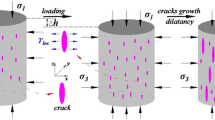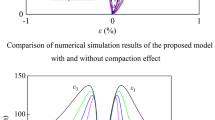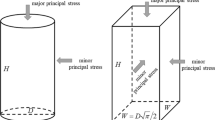Abstract
Kink-bands in rocks have been widely observed in nature and imitated in the laboratory, and the mechanism of their formation has attracted much attention from various researchers for many years. In this paper, a two-phase equilibrium model is presented in which the kink-bands are considered as a high-strain phase and the other regions outside kink-bands as a low-strain phase and the discontinuity of the deformation gradient and stresses is permitted across the interface between those two phases. Based on the present model, we conduct the analysis for the rocks under plane strain compression by finding the minimum value of the compressive loading at which the governing equations have real, physically acceptable solutions. It is revealed that for the rocks with strain-softening behaviour, two-phase equilibrium solutions exist, and the critical value of the compressive loading, the inclination angle of the kink-band, and the stresses and strains inside and outside kink-bands can all be determined by the solution, which are in good agreement with experimental measurements and observations.
Similar content being viewed by others
References
Anderson, T.B., Kink-bands a related geological structures. Nature, 1964, 202(4): 272–274.
Paterson, M.S. and Weiss, L.E., Experimental deformation and folding in phyllite. Geological Society of America Bulletin, 1966, 77(4): 343–374.
Anderson, T.B., The relationship between kink-bands and shear fractures in the experimental deformation of slate. Journal of the Geological Society, 1974, 130(4): 367–382.
Yumlu, M. and Ozbay, M.U., A study of the behaviour of brittle rocks under plane strain and triaxial loading conditions. International Journal of Rock Mechanics and Mining Science & Geomechanics Abstracts, 1995, 32(7): 725–733.
Labuz, J.F. and Carvalho, F.C.S., Post-failure micromechanisms in shear banding of rock. Acoustic Emission-Beyond the Millennium, 2000: 145–158.
Riedel, J.J., Labuz, J.F. and Dai, S.T., Plane strain compression of sandstone under low confinement. In: Labuz, J.F. and Drescher, A., editors. International Workshop on Bifurcations and Instabilities in Geomechanics, 2002 Jun 02–05; Minneapolis, Mn: A Balkema Publishers, 2002: 207–216.
Desrues, J., Tracking strain localization in geomaterials using computerized tomography. In: Otani, J. and Obara, Y., editors. International Workshop on X-Ray CT for Geomaterials(GeoX 2003); 2003 Nov 06–07; Kumamoto, Japan: A Balkema Publishers, 2003: 15–41.
Riedel, J.J. and Labuz, J.F., Propagation of a shear band in sandstone. International Journal for Numerical and Analytical Methods in Geomechanics, 2007, 31(11): 1281–1299.
Borja, R.I., Regueiro, R.A. and Lai, T.Y., FE modeling of strain localization in soft rock. Journal of Geotechnical and Geoenvironmental Engineering, 2000, 126(4): 335–343.
Borja, R.I., Bifurcation of elastoplastic solids to shear band mode at finite strain. Computer Methods in Applied Mechanics and Engineering, 2002, 191(41): 5287–5314.
Sanavia, L., Pesavento, F. and Schrefler, B.A., Finite Element Analysis of Non-isothermal Multiphase Geomaterials with Application to Strain Localization Simulation. Symposium on Advanced Computational Mechanics; 2004 Feb 21; Sydney, Australia: Springer, 2004: 331–348.
Wang, X.B., Failure process and stress-strain curve of plane strain rock specimen with initially random material imperfections. In: Zhou, Y., Tu, S.T. and Xie, X., editors. Asian Pacific Conference for Fracture and Strength (APCFS’06); 2006 Nov 22–25; Sanya, Peoples R China: Trans Tech Publications, 2007: 1133–1136.
Fu, Y.B. and Freidin, A.B., Characterization and stability of two-phase piecewise-homogeneous deformations. The Royal Society of London Proceedings Series A-Mathematical, Physical and Engineering Sciences, 2004 Nov, 460(2051): 3065–3094.
Ericksen, J.L., Equilibrium of bars. Journal of Elasticity, 1975, 5(3): 191–201.
Abeyaratne, R., An admissibility condition for equilibrium shocks in finite elasticity. Journal of Elasticity, 1983, 13(2): 175–184.
Freidin, A.B. and Chiskis, A.M., Phase transition zones in nonlinear elastic isotropic materials. Part 1: Basic relations. Izvestia RAN. Mechanika Tverdogo Tela (Mechanics of Solids), 1994, 29(4): 91–109.
Freidin, A.B. and Chiskis, A.M., Phase transition zones in nonlinear elastic isotropic materials. Part 2: Incompressible materials with a potential depending on one of deformation invariants. Izvestia RAN. Mechanika Tverdogo Tela (Mechanics of Solids), 1994, 29(5): 46–58.
Drucker, D.C. and Prager, W., Soil mechanics and plastic analysis or limit design. the Quarterly of Applied Mathematics, 1952, 10(2): 157–165.
Author information
Authors and Affiliations
Corresponding author
Additional information
Project supported by the National Basic Research Program of China (973 Program, No. 2007CB714001).
Rights and permissions
About this article
Cite this article
Qi, D., Zhang, Y., Ning, J. et al. A model of two-phase equilibrium for formation of kink-bands in rocks. Acta Mech. Solida Sin. 24, 166–175 (2011). https://doi.org/10.1016/S0894-9166(11)60018-9
Received:
Revised:
Published:
Issue Date:
DOI: https://doi.org/10.1016/S0894-9166(11)60018-9




